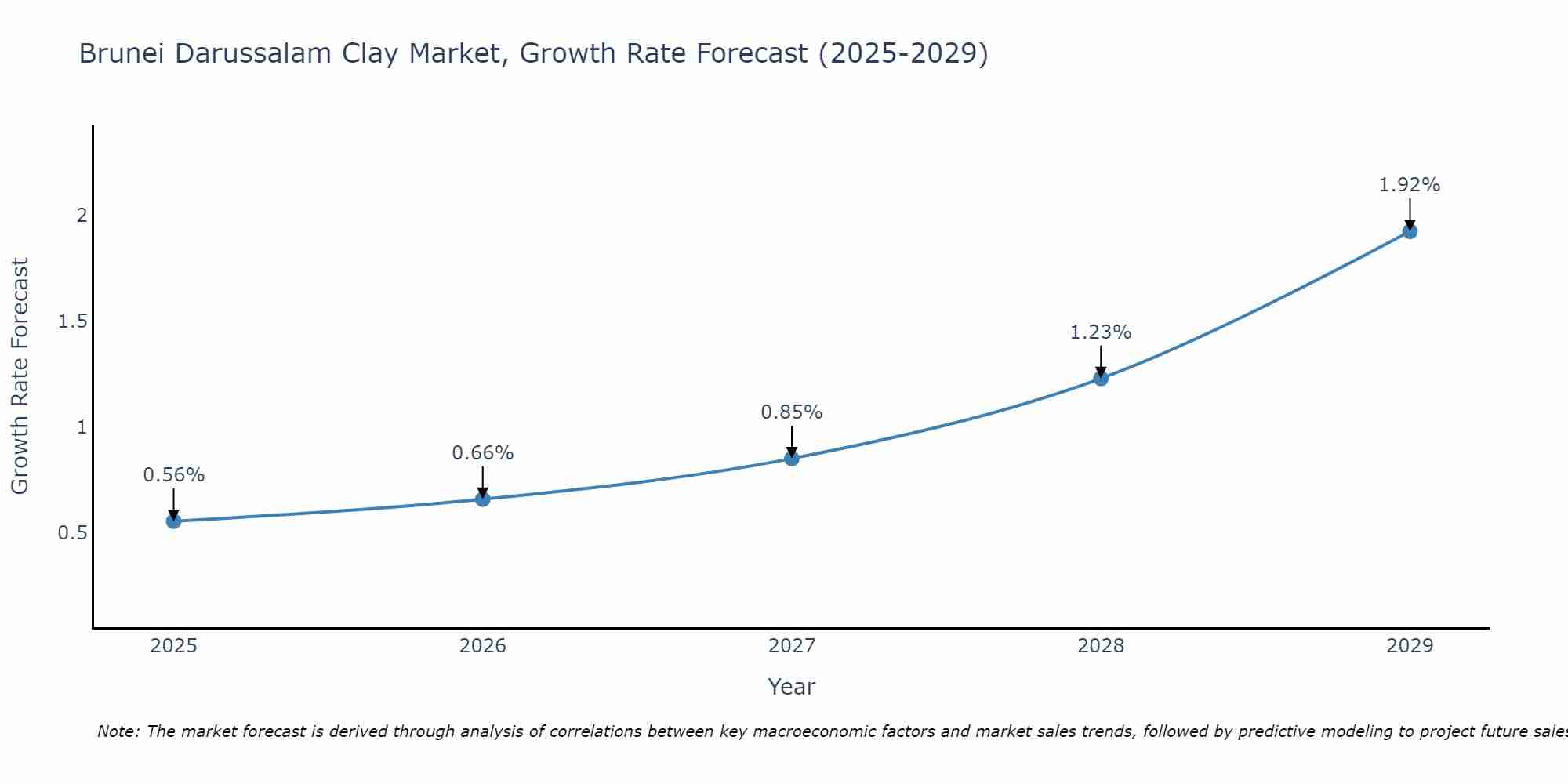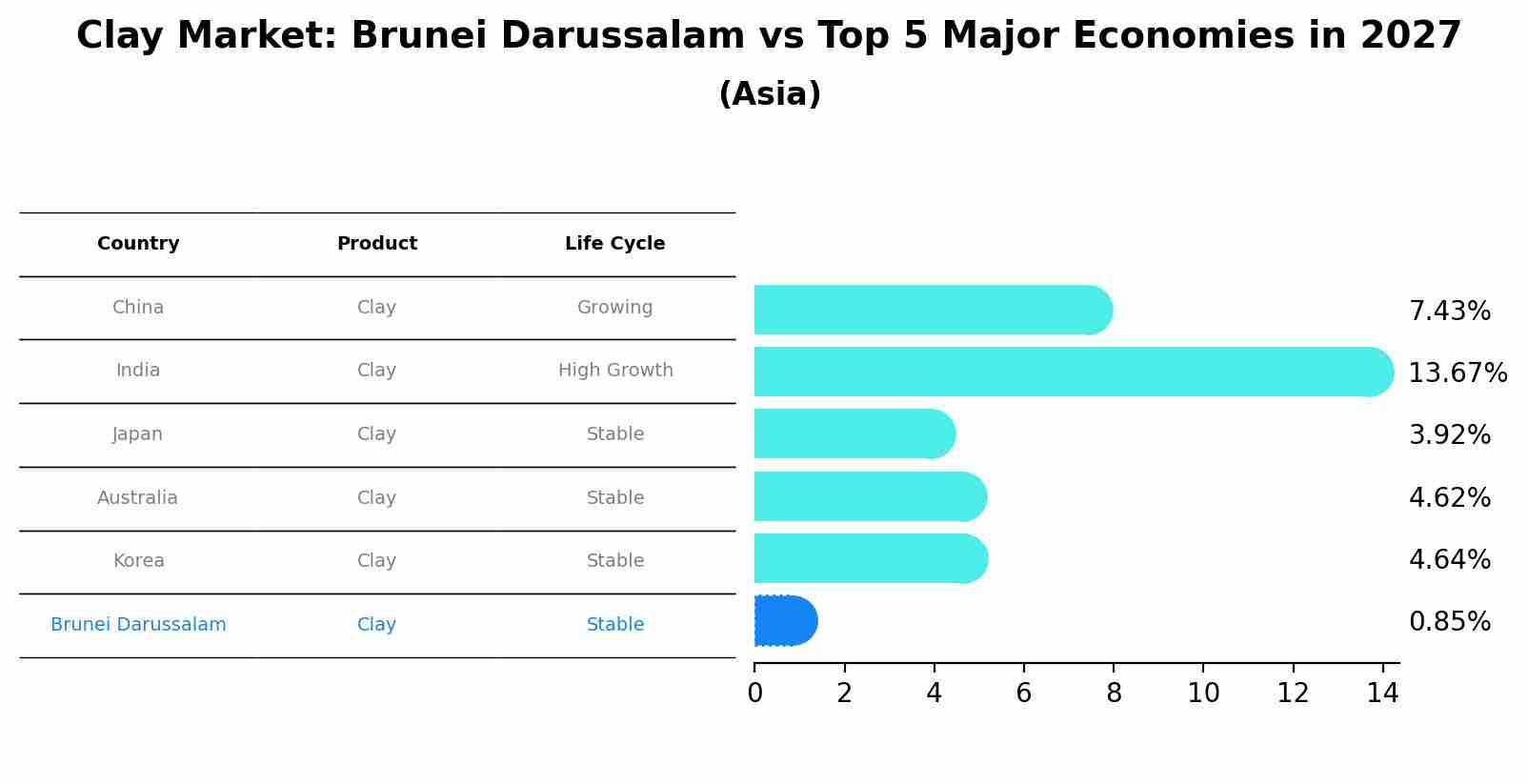Brunei Clay Market (2025-2031) | Size, Companies, Revenue, Outlook, Forecast, Analysis, Trends, Value, Growth, Share, Segmentation & Industry
| Product Code: ETC5257633 | Publication Date: Nov 2023 | Updated Date: Oct 2025 | Product Type: Market Research Report | |
| Publisher: 6Wresearch | Author: Bhawna Singh | No. of Pages: 60 | No. of Figures: 30 | No. of Tables: 5 |
Brunei Darussalam Clay Market Size Growth Rate
The Brunei Darussalam Clay Market is likely to experience consistent growth rate gains over the period 2025 to 2029. The growth rate starts at 0.56% in 2025 and reaches 1.92% by 2029.

Clay Market: Brunei Darussalam vs Top 5 Major Economies in 2027 (Asia)
By 2027, the Clay market in Brunei Darussalam is anticipated to reach a growth rate of 0.85%, as part of an increasingly competitive Asia region, where China remains at the forefront, supported by India, Japan, Australia and South Korea, driving innovations and market adoption across sectors.

Brunei Clay Market Overview
Brunei`s clay market is influenced by the demand for clay in construction, ceramics, and pottery. Clay`s versatility makes it a valuable material for various applications, from building materials to artistic products. The market`s growth is driven by infrastructure development and a growing interest in traditional crafts. However, challenges such as limited local clay resources and competition from imported materials may affect the market`s expansion.
Drivers of the market
The Brunei clay market benefits from its use in various industries, including construction, ceramics, and pottery. The demand for clay in construction for making bricks and tiles, coupled with the growth in the ceramic and pottery sectors, drives market growth. Additionally, the rising popularity of artisanal and handcrafted products, which often use natural clay, contributes to increased demand.
Challenges of the market
The Brunei clay market struggles with issues related to resource availability and environmental regulations. The extraction and processing of clay can be environmentally taxing, leading to stricter regulations and potential delays in operations. Additionally, fluctuations in demand for clay products can impact market stability. There is also the challenge of competing with alternative materials that offer similar benefits at lower costs.
Government Policy of the market
The Brunei government has established policies to support the sustainable extraction and use of clay. These include regulations on mining practices to minimize environmental impact and support for businesses in the clay industry through grants and subsidies. The goal is to ensure the sustainable development of the clay sector while maintaining high environmental standards.
Key Highlights of the Report:
- Brunei Clay Market Outlook
- Market Size of Brunei Clay Market, 2024
- Forecast of Brunei Clay Market, 2031
- Historical Data and Forecast of Brunei Clay Revenues & Volume for the Period 2021-2031
- Brunei Clay Market Trend Evolution
- Brunei Clay Market Drivers and Challenges
- Brunei Clay Price Trends
- Brunei Clay Porter`s Five Forces
- Brunei Clay Industry Life Cycle
- Historical Data and Forecast of Brunei Clay Market Revenues & Volume By Application for the Period 2021-2031
- Historical Data and Forecast of Brunei Clay Market Revenues & Volume By Tableware for the Period 2021-2031
- Historical Data and Forecast of Brunei Clay Market Revenues & Volume By Sanitary ware for the Period 2021-2031
- Historical Data and Forecast of Brunei Clay Market Revenues & Volume By Medical applications for the Period 2021-2031
- Historical Data and Forecast of Brunei Clay Market Revenues & Volume By End Use for the Period 2021-2031
- Historical Data and Forecast of Brunei Clay Market Revenues & Volume By Ceramic and for the Period 2021-2031
- Historical Data and Forecast of Brunei Clay Market Revenues & Volume By Non-ceramic for the Period 2021-2031
- Brunei Clay Import Export Trade Statistics
- Market Opportunity Assessment By Application
- Market Opportunity Assessment By End Use
- Brunei Clay Top Companies Market Share
- Brunei Clay Competitive Benchmarking By Technical and Operational Parameters
- Brunei Clay Company Profiles
- Brunei Clay Key Strategic Recommendations
Frequently Asked Questions About the Market Study (FAQs):
1 Executive Summary |
2 Introduction |
2.1 Key Highlights of the Report |
2.2 Report Description |
2.3 Market Scope & Segmentation |
2.4 Research Methodology |
2.5 Assumptions |
3 Brunei Clay Market Overview |
3.1 Brunei Country Macro Economic Indicators |
3.2 Brunei Clay Market Revenues & Volume, 2021 & 2031F |
3.3 Brunei Clay Market - Industry Life Cycle |
3.4 Brunei Clay Market - Porter's Five Forces |
3.5 Brunei Clay Market Revenues & Volume Share, By Application, 2021 & 2031F |
3.6 Brunei Clay Market Revenues & Volume Share, By End Use, 2021 & 2031F |
4 Brunei Clay Market Dynamics |
4.1 Impact Analysis |
4.2 Market Drivers |
4.2.1 Increasing demand for eco-friendly and sustainable products |
4.2.2 Growing construction and infrastructure development projects in Brunei |
4.2.3 Rising interest in arts and crafts activities using clay |
4.3 Market Restraints |
4.3.1 Fluctuating raw material prices impacting production costs |
4.3.2 Competition from alternative materials like polymer clay |
4.3.3 Limited availability of skilled clay artisans in Brunei |
5 Brunei Clay Market Trends |
6 Brunei Clay Market Segmentations |
6.1 Brunei Clay Market, By Application |
6.1.1 Overview and Analysis |
6.1.2 Brunei Clay Market Revenues & Volume, By Tableware, 2021-2031F |
6.1.3 Brunei Clay Market Revenues & Volume, By Sanitary ware, 2021-2031F |
6.1.4 Brunei Clay Market Revenues & Volume, By Medical applications, 2021-2031F |
6.2 Brunei Clay Market, By End Use |
6.2.1 Overview and Analysis |
6.2.2 Brunei Clay Market Revenues & Volume, By Ceramic and, 2021-2031F |
6.2.3 Brunei Clay Market Revenues & Volume, By Non-ceramic, 2021-2031F |
7 Brunei Clay Market Import-Export Trade Statistics |
7.1 Brunei Clay Market Export to Major Countries |
7.2 Brunei Clay Market Imports from Major Countries |
8 Brunei Clay Market Key Performance Indicators |
8.1 Percentage increase in online searches for clay-related DIY projects in Brunei |
8.2 Number of new clay art workshops or studios opening in the market |
8.3 Growth in the number of local clay product exhibitions and fairs in Brunei |
9 Brunei Clay Market - Opportunity Assessment |
9.1 Brunei Clay Market Opportunity Assessment, By Application, 2021 & 2031F |
9.2 Brunei Clay Market Opportunity Assessment, By End Use, 2021 & 2031F |
10 Brunei Clay Market - Competitive Landscape |
10.1 Brunei Clay Market Revenue Share, By Companies, 2024 |
10.2 Brunei Clay Market Competitive Benchmarking, By Operating and Technical Parameters |
11 Company Profiles |
12 Recommendations | 13 Disclaimer |
- Single User License$ 1,995
- Department License$ 2,400
- Site License$ 3,120
- Global License$ 3,795
Search
Related Reports
- ASEAN and Thailand Brain Health Supplements Market (2025-2031) | Strategy, Consumer Insights, Analysis, Investment Trends, Opportunities, Growth, Size, Share, Industry, Revenue, Segments, Value, Segmentation, Supply, Forecast, Restraints, Outlook, Competition, Drivers, Trends, Demand, Pricing Analysis, Competitive, Strategic Insights, Companies, Challenges
- ASEAN Bearings Market (2025-2031) | Strategy, Consumer Insights, Analysis, Investment Trends, Opportunities, Growth, Size, Share, Industry, Revenue, Segments, Value, Segmentation, Supply, Forecast, Restraints, Outlook, Competition, Drivers, Trends, Demand, Pricing Analysis, Competitive, Strategic Insights, Companies, Challenges
- Europe Flooring Market (2025-2031) | Outlook, Share, Industry, Trends, Forecast, Companies, Revenue, Size, Analysis, Growth & Value
- Saudi Arabia Manlift Market (2025-2031) | Outlook, Size, Growth, Trends, Companies, Industry, Revenue, Value, Share, Forecast & Analysis
- Uganda Excavator, Crane, and Wheel Loaders Market (2025-2031) | Strategy, Consumer Insights, Analysis, Investment Trends, Opportunities, Growth, Size, Share, Industry, Revenue, Segments, Value, Segmentation, Supply, Forecast, Restraints, Outlook, Competition, Drivers, Trends, Demand, Pricing Analysis, Competitive, Strategic Insights, Companies, Challenges
- Rwanda Excavator, Crane, and Wheel Loaders Market (2025-2031) | Strategy, Consumer Insights, Analysis, Investment Trends, Opportunities, Growth, Size, Share, Industry, Revenue, Segments, Value, Segmentation, Supply, Forecast, Restraints, Outlook, Competition, Drivers, Trends, Demand, Pricing Analysis, Competitive, Strategic Insights, Companies, Challenges
- Kenya Excavator, Crane, and Wheel Loaders Market (2025-2031) | Strategy, Consumer Insights, Analysis, Investment Trends, Opportunities, Growth, Size, Share, Industry, Revenue, Segments, Value, Segmentation, Supply, Forecast, Restraints, Outlook, Competition, Drivers, Trends, Demand, Pricing Analysis, Competitive, Strategic Insights, Companies, Challenges
- Angola Excavator, Crane, and Wheel Loaders Market (2025-2031) | Strategy, Consumer Insights, Analysis, Investment Trends, Opportunities, Growth, Size, Share, Industry, Revenue, Segments, Value, Segmentation, Supply, Forecast, Restraints, Outlook, Competition, Drivers, Trends, Demand, Pricing Analysis, Competitive, Strategic Insights, Companies, Challenges
- Israel Intelligent Transport System Market (2025-2031) | Strategy, Consumer Insights, Analysis, Investment Trends, Opportunities, Growth, Size, Share, Industry, Revenue, Segments, Value, Segmentation, Supply, Forecast, Restraints, Outlook, Competition, Drivers, Trends, Demand, Pricing Analysis, Competitive, Strategic Insights, Companies, Challenges
- Uganda Precast and Aggregate Market (2025-2031) | Strategy, Consumer Insights, Analysis, Investment Trends, Opportunities, Growth, Size, Share, Industry, Revenue, Segments, Value, Segmentation, Supply, Forecast, Restraints, Outlook, Competition, Drivers, Trends, Demand, Pricing Analysis, Competitive, Strategic Insights, Companies, Challenges
Industry Events and Analyst Meet
Our Clients
Whitepaper
- Middle East & Africa Commercial Security Market Click here to view more.
- Middle East & Africa Fire Safety Systems & Equipment Market Click here to view more.
- GCC Drone Market Click here to view more.
- Middle East Lighting Fixture Market Click here to view more.
- GCC Physical & Perimeter Security Market Click here to view more.
6WResearch In News
- Doha a strategic location for EV manufacturing hub: IPA Qatar
- Demand for luxury TVs surging in the GCC, says Samsung
- Empowering Growth: The Thriving Journey of Bangladesh’s Cable Industry
- Demand for luxury TVs surging in the GCC, says Samsung
- Video call with a traditional healer? Once unthinkable, it’s now common in South Africa
- Intelligent Buildings To Smooth GCC’s Path To Net Zero













